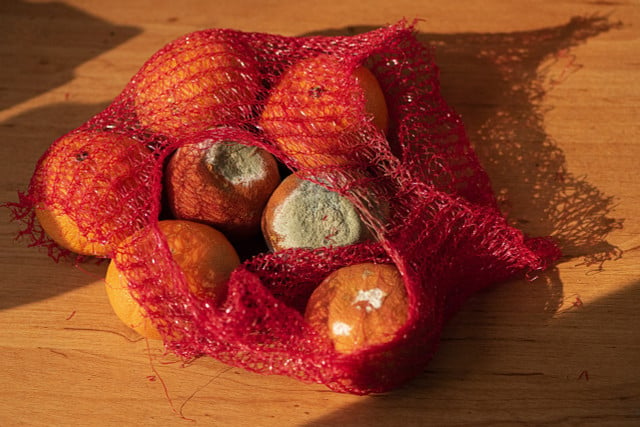
Mycotoxins are toxins from molds that can contaminate food. There are many different mycotoxins, some of which are harmful to the health of humans and animals.
There are several hundred mycotoxins that can get into food and feed. They are metabolic products of mold. According to the Federal Institute for Risk Assessment (BfR), certain mycotoxins can be harmful to humans and animals even in small quantities.
Mold often attacks plants before harvest or during storage, transport or processing. But mycotoxins can also reach the end consumer via contaminated feed “through muscle meat, eggs and milk,” explains the Bavarian Ministry of Consumer Affairs (VIS). Harmful effects can therefore occur even after a single ingestion of the mold toxins.
Mycotoxins in food: a threat to health

(Photo: CC0 / Pixabay / ShotRAV)
Mycotoxins can be harmful to health:
- “Serious damage to various organs is possible in animals and humans after single or repeated ingestion of aflatoxins, ochratoxin A, fumonisins, citrinin or ergot alkaloids,” says the VIS. The greatest danger is posed by the carcinogenic aflatoxin B1.
- In the past, there have also been cases of serious poisoning with liver damage in regions of Africa and Southeast Asia in connection with mycotoxins. High levels of certain mycotoxins can lead to death due to liver failure. Small amounts over a longer period of time can cause liver tumors. However, the carcinogenic potential of the individual mycotoxins differs greatly from one another.
- Some mycotoxins are suspected of damaging genetic material or fertility, explains the Ministry of Consumer Protection. Malformations as well as nausea, vomiting and diarrhea are other dangers.
In Germany and other Central European countries, however, the risk of mycotoxin disease is very low, according to Lower Saxony’s Ministry for Food Safety. This is due to the good quality of the food and frequent controls. “However, due to poor growth, storage and transport conditions as well as special eating habits, particularly in subtropical and tropical areas of Africa and Asia, acute poisonings with fatalities have repeatedly occurred due to the consumption of peanuts or corn products that are heavily contaminated with aflatoxins,” says the ministry. Since mycotoxins are heat-stable, cooking cannot kill the toxins either.
How do mycotoxins get into food?

(Photo: Sven Christian Schulz / Utopia)
Foods that contain a lot of carbohydrates, vegetable and animal oils, nitrogen and a soft, large-pored surface are particularly susceptible to mycotoxins. Moldy food in the home is also contaminated with mycotoxins. But raw materials can be contaminated with mold toxins even before further processing and purchase: in the case of grain, for example, mold can occur in the field or during storage.
The Ministry for Food Safety in Lower Saxony points out: “The amount of toxins is not correlated with fungal growth.” A small mold on food can therefore already contain a lot of the toxic mycotoxins. In addition, mold also grows into food and releases mycotoxins there. Plant-based foods in particular are susceptible to certain mycotoxins:
-
Aflatoxins: Peanuts, nuts, dried fruits, cereals/flour, spices
-
OTA: cereals/flour, dried fruits, coffee, wine, beer, grape juice, cocoa, spices
-
Patulin: Fruits
-
Fusarium toxins: cereals/flour and maize
-
Ergot alkaloids: cereals/flour
-
Alternaria toxins: tomatoes and tomato products
-
Citrinin: Rice
Mycotoxins also form on moldy garbage or when mold is in walls. The fungal spores can then enter the respiratory tract via the air.
Preventing mycotoxins: What you can do
The best thing to do is to make sure that no mold forms in the first place:
- Only buy as much as you can eat. If you cook or buy too much, freeze it or preserve it in a jar (see: Preserving food: 3 easy methods).
- Store food in a dry, cool place. Heat and moisture encourage mold. More details in the article “Storing food properly”.
-
Experts recommend not eating moldy food. However, if only one slice of bread is moldy, you should throw away the one or two slices underneath and you can still eat the rest of the bread. If there is a lot of mold, you shouldn’t eat it at all – health comes first.
- People with a mold allergy, children, pregnant women and people with a weakened immune system should be particularly careful. They should not eat contaminated food – even if the mold has been generously cut off beforehand.
More on the topic at Techzle\.com:
- Strawberry is moldy: does the whole bowl have to go in the trash?
- Eaten mold: What you should consider now
- Remove and prevent mold – but do it right
Edited by Lena Kirchner
** marked with ** or orange underlined Links to sources are partly affiliate links: If you buy here, you are actively supporting Techzle\.com, because we then receive a small part of the sales proceeds. .